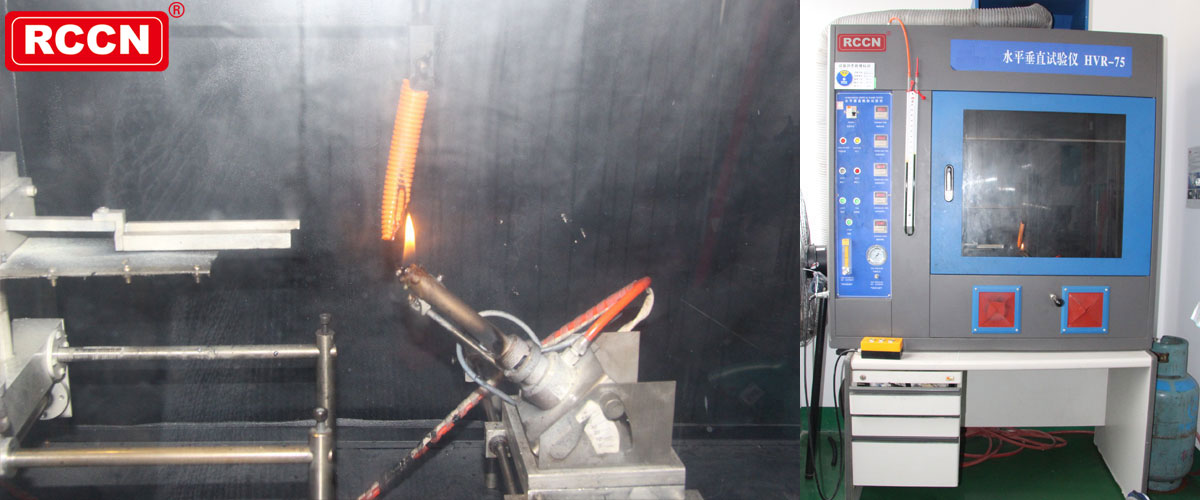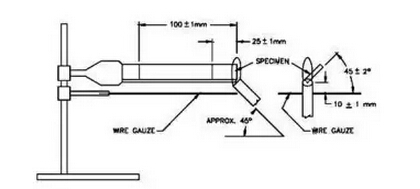 Flame retardant test Introduction:
Flame retardant test Introduction:
The flammability of the material refers to the ability of the material or article to perform flame burning under specified test conditions. It covers some of the characteristics of whether it is easy to ignite, and whether it can maintain the ability to burn. After years of development, the flame resistance test has formed a variety of standards, as the industry is very focused on the detection project.
Flame retardant test Purpose:
Through the customer to provide samples of the combustion test, according to the results of the combustion of the corresponding rating, to help customers to product quality control. Flammability rating is one of the most important safety features that are essential for many certifications and are mandatory for many countries.
Flame retardant test Application:
Mainly used in plastics, foam, film, textile, paint, rubber, automotive interior parts, electrical and electronic products.
Test criteria:
Plastics - Determination of combustion performance - Horizontal and vertical methods GB / T
2. GB / T 5169.16-2008 Fire hazard testing for electric and electronic products - Part 16: Test flame 50W Horizontal and vertical flame test methods
Information technology - Safety of equipment - Part 1: General requirements

UL 94 test technology
Test object
The UL-94 test measures the flammability of plastics used in the manufacture of equipment and appliances and is often used to detect products with special requirements for flammability, with the result being the most basic indication. Are often used to assess lightness, burning speed, flame propagation, and fuel contribution, but are not limited to these uses.
UL 94 Flame Retardant Test Classification
▲HB level combustion test
▲94V-0,94V-1,94V-2 vertical combustion test
▲94V-5 vertical combustion test
The content of each flame retardant test content
|
|
experiment method |
Request condition |
Precautions |
|
94HB |
Will be 20mm of the flame tilted 45 degrees, contact test
|
A. Thickness is 3.0-13mm, burning speed 40mm / min or less.
|
Three groups, if one of them qualified,
|
|
94V-0 |
So that the flame contact sample for 10 seconds, and then time,
|
A. Sample burn after burning time in 10 seconds or less.
|
Five groups, if one of the unqualified,
|
|
94V-1 |
A. Sample burn after burning time in less than 30 seconds.
|
||
|
94V-2 |
A. Sample burn after burning time in 10 seconds or less.
|
||
|
Flame contact for 5 seconds, remove the flame for 5 seconds, |
|
A. After 5 contact with the flame, the burning light flash time not more than 60 seconds.
|
Five groups, if one of them failed,
|
具体分级指标如下:
|
|
94V-0 |
94V-1 |
94V-2 |
94V-5 |
|
Number of styles |
5 |
5 |
5 |
5 |
|
The number of times of ignition |
2 |
2 |
2 |
2 |
|
5 test strips 10 times the total length of the flame burning time(s) |
50 |
250 |
250 |
250 |
|
Each time a single test piece has a flame burning time maximum (s) |
10 |
30 |
30 |
60 |
|
Every second lit after a single test piece Flameless burning time (s) |
30 |
60 |
60 |
60 |
|
There is no smoke drop |
no |
no Only allowed to burn for a short time |
|
experimental method
The UL-94 test method (UL-94 method developed in accordance with US countries) is widely used in related flammability assays and evaluates the dripping of plastics used in electrical and electronic equipment.

Figure 1 V-0, V-1, V-2 UL-94 test method schematic

Figure 2 HB-level UL-94 test method schematic
In the course of the experiment, methane is used as the main combustion gas. The combustion flame is generally 20mm and 125mm. In the two groups, the air flow is adjusted at 105ml / min and 965ml / min respectively, and the flame is corrected once a month.
EXPERIMENTAL PRECAUTIONS: If the naked eye is difficult to distinguish between burning and glowing, a 50mm square absorbent absorbent may be placed in the area of doubt and clamped with tweezers. If the cotton swabs prove that the area is a burning section. If the flame is extinguished at any time for the fire test, the sample will be tested. The only exception is the fact that the experimental flames are caused by deflation directly, and in this case the fire is immediately supplied to the specimen until the fire time reaches 10 ± 0.5 s.
★ sample conditions
1.23 ± 2 ° C and 50 ± 5 ° C RH for at least 48 hours;
2. was allowed to stand at 70 ± 1 ° C for 168 hours and then cooled in a dryer at 23 ± 2 ° C for 4 hours;
3. Laboratory temperature is 15-35 ℃, humidity is 45-75%;
4. The cotton in the dryer is placed at least 24 hours prior to use;
5. Samples and cotton should be used within 30 minutes.
















 RCCN WeChat QrCode
RCCN WeChat QrCode Mobile WebSite
Mobile WebSite